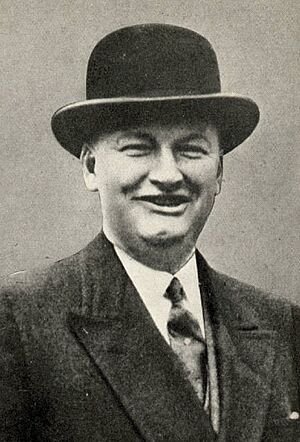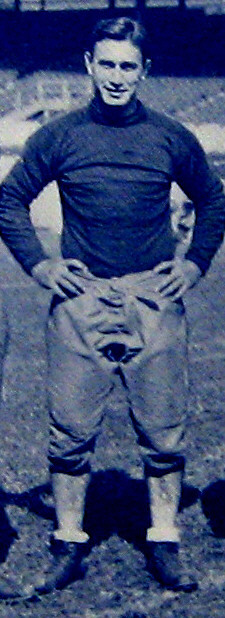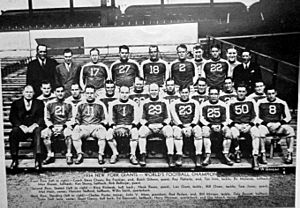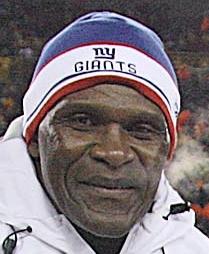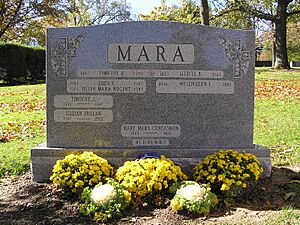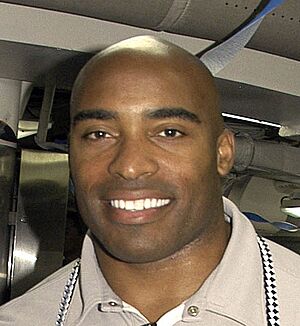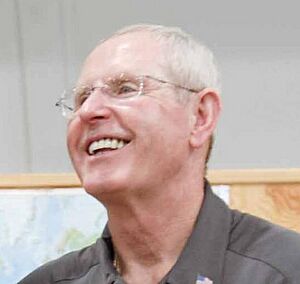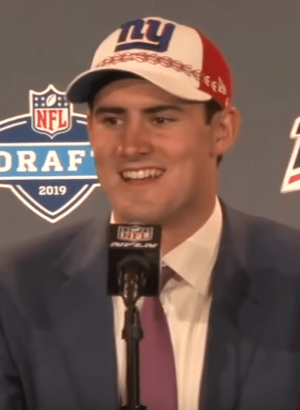History of the New York Giants facts for kids
The New York Giants are a famous American football team that plays in the National Football League (NFL). They are part of the National Football Conference (NFC). The Giants have a long history, going back more than 80 seasons. They have won eight NFL championships, including four Super Bowls!
The team was started in 1925 by Tim Mara. He owned the team until he passed away in 1959. Then, his sons, Wellington Mara and Jack Mara, took over. In just their third season, the Giants had an amazing record of 11 wins, 1 loss, and 1 tie. They were awarded the NFL title that year.
From 1933 to 1947, the Giants played in the NFL championship game eight times. They won twice, in 1934 and 1938. They didn't win another championship until 1956. This win was helped by future Hall of Fame players like Frank Gifford, Sam Huff, and Roosevelt Brown. Between 1958 and 1963, the Giants played in the NFL championship game five more times, but they couldn't win. The 1958 NFL Championship game, where they lost to the Baltimore Colts in overtime, became very famous. Many people say this game helped make the NFL super popular in the United States.
The Giants had a tough time from 1964 to 1980, with only two winning seasons. They didn't make it to the playoffs. But from 1981 to 1990, they made the playoffs seven times! They won Super Bowl XXI and Super Bowl XXV. This success in the 1980s was thanks to head coach Bill Parcells, quarterback Phil Simms, and Hall of Fame linebackers Lawrence Taylor and Harry Carson. The 1990s were harder for the Giants. Parcells left, and star players like Simms and Taylor retired. They did reach the Super Bowl again in 2000, but lost to the Baltimore Ravens in Super Bowl XXXV. Later, the Giants won two more Super Bowls against the New England Patriots: Super Bowl XLII and Super Bowl XLVI.
Contents
Early Years and First Wins: 1925–1930
The Giants started in 1925 when Tim Mara invested $500. Their official name was "New York Football Giants." This helped tell them apart from the baseball team with the same name. They were one of the first teams in the NFL, which was only five years old.
The New York Football Giants played their first game on October 5, 1925, in New Britain, Connecticut.
Even though the Giants played well in their first season (winning 8 games and losing 4), they had money problems. Professional football wasn't very popular yet. But then, in their 11th game, Red Grange and the Chicago Bears came to play. Over 73,000 fans showed up! This brought in much-needed money and might have saved the team.
In 1927, New York had an amazing 11–1–1 record. Their defense was super strong, with 10 shutouts in 13 games. New coach Earl Potteiger led them to their first championship.
After a tough 1928 season, LeRoy Andrews became the new coach. Before the 1929 season, Mara bought all the players from the Detroit Wolverines, including star quarterback Benny Friedman. With Friedman, New York's record jumped to 13–1–1. However, they lost one game to the Green Bay Packers, who then won the NFL title. After this season, Mara gave ownership to his sons, Jack (22) and Wellington (14), to protect the team from money issues.
In 1930, some people still thought college football was better than professional football. To prove them wrong, the Giants played a team of Notre Dame All-Stars. This game also raised money for people in New York City who didn't have jobs. The Giants won easily, and Notre Dame didn't score any points. This game helped show everyone how good professional football really was. It also raised $115,183 for those in need.
The Steve Owen Years: 1931–1953
Before the 1931 season, the Giants hired Steve Owen as their player-head coach. He coached the team for 23 years, winning two NFL championships. He was later put into the Pro Football Hall of Fame. Owen coached the entire time without a written contract, just a handshake!
In 1933, the Giants got a new quarterback, Harry Newman, and a great halfback, Ken Strong. New York finished 11–3 and won their division. Newman led the NFL in passing yards and touchdowns. The team had strong linemen like Ray Flaherty and future Hall of Famers Red Badgro and Mel Hein. They played in the NFL's first official championship game against the Chicago Bears, but lost a close game, 23–21.
In the 1934 NFL Championship Game, the Giants played the undefeated Chicago Bears on a very icy field. The Giants wore regular shoes and were losing 10–3 at halftime. During halftime, the equipment manager, Abe Cohen, found nine pairs of basketball sneakers. The players put them on, and the Giants scored 27 unanswered points in the fourth quarter! They won 30–13. This game is famous as "The Sneakers Game."
The Giants couldn't win the championship in 1935, losing to the Detroit Lions. But from 1936 to 1941, they were one of the best teams in the NFL. They won their third NFL championship in 1938, beating the Green Bay Packers 23–17.
The Giants reached the championship game again in 1939 and 1941, but lost both times. In 1944, they played the Packers again for the championship. This Giants team had one of the best defenses ever, giving up only 7.5 points per game. But they still lost 14–7. By 1946, Tim Mara had given full control of the team to his sons, Jack and Wellington. In 1946, the Giants made it to the championship game for the eighth time in 14 seasons, but lost to the Chicago Bears.
In 1948, the Giants signed Emlen Tunnell, their first African American player. He later became the first African American in the Hall of Fame. The team struggled for a few years but came back strong in 1950 with a 10–2 record. However, they lost in the playoffs to the Cleveland Browns.
New Coach, New Wins: 1954–1958
After 23 years, coach Steve Owen was replaced by Jim Lee Howell in 1954. This was a very hard decision for the Mara family.
The Giants won their fourth NFL Championship in 1956. They played their home games at Yankee Stadium for the first time. In the NFL Championship Game, on an icy field, the Giants wore sneakers again, just like in 1934! They crushed the Chicago Bears, winning 47–7. The 1956 Giants had many future Hall of Fame players, including Frank Gifford, Sam Huff, and Roosevelt Brown. Also, their coaches, Tom Landry (defense) and Vince Lombardi (offense), later became famous Hall of Fame head coaches themselves.
The Greatest Game Ever Played: 1958
The Giants had another great year in 1958. They tied for their division title and then beat the Cleveland Browns in a playoff game. This sent them to the NFL Championship Game against the Baltimore Colts. This game became known as "The Greatest Game Ever Played." It's seen as a huge moment that helped professional football become so popular.
The game was very exciting. The Giants led early, but the Colts took a 14–3 lead at halftime. In the third quarter, the Giants' defense made a huge stop near their own goal line. This changed the game! New York then drove 95 yards for a touchdown. Later, quarterback Charlie Conerly threw a touchdown pass to Frank Gifford, giving the Giants a 17–14 lead.
But the Colts made one last drive. With only seven seconds left, they kicked a field goal to tie the score 17–17. This was the first NFL championship game to go into overtime! The Colts won the coin toss, got the ball, and scored a touchdown to win 23–17.
More Success and Tough Times: 1959–1978
The Giants kept winning in the early 1960s. They reached the championship game three more times from 1961 to 1963, led by quarterback Y. A. Tittle. But they lost all three games to the Green Bay Packers and Chicago Bears.
After 1963, the team struggled. Many older players left, and the Giants had a long period without making the playoffs. This time is sometimes called "the wilderness years." They also played in different stadiums, like the Yale Bowl and Shea Stadium, before moving to Giants Stadium in New Jersey in 1976.
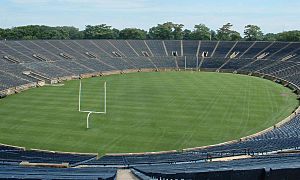
In 1967, the Giants got quarterback Fran Tarkenton. They improved, but still couldn't make the playoffs. In 1970, running back Ron Johnson became the first Giant to run for over 1,000 yards in a season.
The "Fumble" Game: 1978
In 1978, the Giants were playing the Philadelphia Eagles. They were winning 17–12 with only 30 seconds left. All they had to do was kneel the ball to end the game. But instead, the coach told quarterback Joe Pisarcik to hand the ball off. The ball was fumbled, and an Eagles player picked it up and ran for a touchdown! The Eagles won 19–17. This play is known as "The Miracle in the Meadowlands" or "The Fumble." After this, the coach was fired.
Building a Champion: 1979–1990
After the "Fumble" game, the Giants hired George Young as their first general manager. He hired Ray Perkins as head coach and drafted quarterback Phil Simms. The team was still struggling, but then in 1981, they drafted linebacker Lawrence Taylor.
Taylor's impact was huge! He was named Defensive Rookie of the Year and Defensive Player of the Year. With Taylor, Harry Carson, and Brad Van Pelt, the Giants had one of the best groups of linebackers in the NFL. Their defense became much stronger. The Giants made the playoffs in 1981, winning their first game before losing to the San Francisco 49ers.
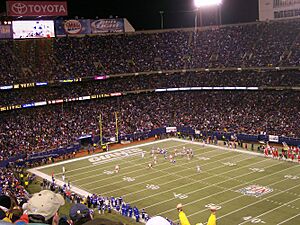
In 1983, Bill Parcells became the new head coach. After a tough first year, the Giants improved in 1984, making the playoffs again. Phil Simms threw for over 4,000 yards, a first for a Giants quarterback. In 1985, the defense was amazing, leading the NFL in sacks. They won their first home playoff game since 1958, but then lost to the Chicago Bears.
1986: Super Bowl Champions
The Giants were a top team in 1986. They finished the season with a fantastic 14–2 record. Their defense was second best in the NFL, and Lawrence Taylor set a team record with 20.5 sacks. He won his third Defensive Player of the Year award and was even named the league's MVP!
The Giants crushed the San Francisco 49ers and then the Washington Redskins in the playoffs. This sent them to Super Bowl XXI against the Denver Broncos. After being down 10–9 at halftime, the Giants came back strong and won 39–20! Phil Simms was named the Super Bowl MVP, completing an amazing 88% of his passes, a Super Bowl record.
1987–1989
The Giants had some ups and downs after their Super Bowl win. In 1987, a players' strike affected the season. In 1988, they had a good 10–6 record but missed the playoffs due to tie-breaking rules. In 1989, they had a 12–4 record but lost a close overtime playoff game to the Los Angeles Rams.
1990: Champions Again
The Giants started the 1990 season by winning their first 10 games, a team record! They had a big game against the San Francisco 49ers, who were also 10–0. The Giants' defense played great, holding the 49ers to only seven points, but the Giants only scored three.
Later in the season, quarterback Phil Simms got injured. Jeff Hostetler, a backup, had to step in. The Giants finished the regular season with a 13–3 record. They beat the Chicago Bears in the playoffs, setting up a rematch with the 49ers for the NFC Championship. The Giants' defense was amazing again. In the final moments, they forced a fumble, and kicker Matt Bahr made a 42-yard field goal as time ran out! The Giants won 15–13.
Super Bowl XXV
The Giants then faced the Buffalo Bills in Super Bowl XXV. This game happened during the Persian Gulf War, and it felt very patriotic. The Bills started strong, but the Giants fought back. The Giants had a record-setting drive that lasted over nine minutes, ending with a touchdown run by Ottis Anderson. This gave them a 17–12 lead.
In the fourth quarter, the Bills scored a touchdown to go up 19–17. But the Giants drove down the field, and Matt Bahr kicked a field goal to make it 20–19. The Bills had one last chance for a game-winning field goal. Kicker Scott Norwood tried a 47-yard kick, but it went wide right! The Giants won their second Super Bowl, 20–19.
The Giants held the ball for a Super Bowl record 40 minutes and 33 seconds. Ottis Anderson was named the game's MVP.
End of an Era
After this Super Bowl win, things changed. Defensive coordinator Bill Belichick left, and then head coach Bill Parcells also left. Also, Tim Mara's son, Tim Mara, sold his half of the team to Bob Tisch. This was the first time since 1925 that the Mara family didn't fully own the team.
New Coaches and Challenges: 1991–2003
After Parcells, Ray Handley became head coach. The team struggled, and star players like Lawrence Taylor got injured or retired. The Giants had losing seasons in 1991 and 1992, and Handley was fired.
Dan Reeves took over as head coach in 1993. He brought back Phil Simms as the starting quarterback. The defense improved, and the Giants finished 11–5, making the playoffs. They won their first playoff game but lost to the San Francisco 49ers. After this season, Lawrence Taylor and Phil Simms, two of the Giants' biggest stars, retired.
The Giants had tough seasons from 1994 to 1996, missing the playoffs.
Jim Fassel Era and Super Bowl XXXV
In 1997, Jim Fassel became the new head coach. The team improved, winning the NFC East division with a 10–5–1 record. But they lost a close playoff game to the Minnesota Vikings. After this season, George Young left, and Ernie Accorsi became the new general manager.
The Giants struggled in 1998. Before the 1999 season, the Giants signed quarterback Kerry Collins. In 1999, Tiki Barber became a great running back, and Amani Toomer had a breakout season as a wide receiver. The defense was strong, but the Giants missed the playoffs.
The 2000 season was very important for Coach Fassel. After a tough start, he famously guaranteed that the team would make the playoffs. The Giants responded by winning their last five regular season games, finishing 12–4. They earned a bye and home-field advantage as the top team in the NFC.
The Giants won their playoff games against the Philadelphia Eagles and then crushed the Minnesota Vikings 41–0 in the NFC Championship game! This sent them to Super Bowl XXXV against the Baltimore Ravens. The Ravens' defense was too strong, and the Giants lost 34–7. Kerry Collins had a very tough game.
After the Super Bowl, the Giants had mixed results. In 2001, Michael Strahan broke the NFL record with 22.5 sacks. In 2002, Kerry Collins threw for over 4,000 yards, and Tiki Barber ran for 1,386 yards. Rookie tight end Jeremy Shockey also had a great season. The Giants made the playoffs but lost a wild game to the San Francisco 49ers, 39–38, due to a bad snap on a last-second field goal try. In 2003, the Giants had a very bad season, losing their last eight games. Jim Fassel was fired before the end of the season.
The Eli Manning Era: 2004–2019
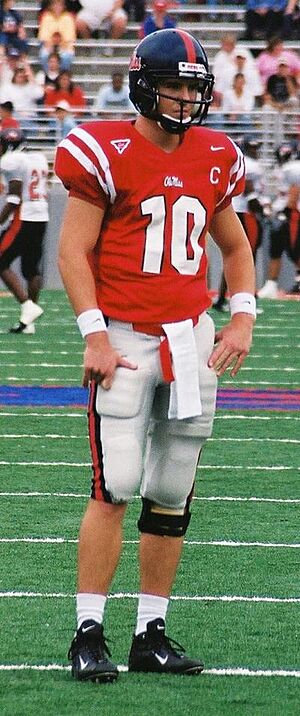
In 2004, Tom Coughlin became the new head coach. He was known for being very strict. The Giants also traded for quarterback Eli Manning, the brother of famous quarterback Peyton Manning. Eli was drafted first overall by the San Diego Chargers, but he didn't want to play for them. So, the Giants traded for him. Veteran quarterback Kurt Warner started the season, but Eli Manning took over later in the year. The Giants finished 6–10. Tiki Barber had a career-high 1,518 rushing yards.
In 2005, the Giants started 4–2. Then, sadly, Wellington Mara, who had been with the Giants since he was nine years old, passed away. Just 20 days later, the other co-owner, Bob Tisch, also passed away. The Giants honored them with wins. Tiki Barber set new team records for rushing yards in a game (220) and a season (1,860). The Giants finished 11–5 but lost in the playoffs.
The 2006 season was inconsistent, and the Giants finished 8–8, making the playoffs as a wild card but losing to the Philadelphia Eagles.
2007: Third Super Bowl Championship
In 2007, the Giants made the playoffs again. They set an NFL record by sacking the Philadelphia Eagles quarterback 12 times in one game! They also became the third NFL team to win 600 games. They even played the first regular season NFL game outside North America, in London, where they won. The Giants finished 10–6 and went on an amazing playoff run. They beat the Tampa Bay Buccaneers, then upset the top-seeded Dallas Cowboys, and finally won the NFC Championship game in overtime against the Green Bay Packers.
In Super Bowl XLII, the Giants faced the New England Patriots, who were undefeated! The Patriots were expected to win easily. But the Giants pulled off one of the biggest upsets in Super Bowl history, winning 17–14. The most famous play was when Eli Manning escaped several defenders and threw a long pass to David Tyree, who caught the ball against his helmet! A few plays later, Manning threw the game-winning touchdown pass to Plaxico Burress. Eli Manning was named the Super Bowl MVP. After this game, Michael Strahan retired as the team's all-time leader in sacks.
2008–2016
In 2008, the Giants had a great 12–4 record and were the top team in the NFC. But they lost in the playoffs to the Philadelphia Eagles. Eli Manning had a good season and was named to the Pro Bowl. Running backs Brandon Jacobs and Derrick Ward both ran for over 1,000 yards.
The Giants had some tough seasons from 2009 to 2011. In 2010, they moved into the new MetLife Stadium. In 2011, they had a strong finish to the season, winning their division. They beat the Atlanta Falcons and then upset the top-seeded Green Bay Packers in the playoffs. This sent them to the NFC Championship game against the San Francisco 49ers, which they won in overtime!
The New York Giants then won Super Bowl XLVI against the New England Patriots, 21–17. Just like in Super Bowl XLII, Eli Manning was the game's MVP, beating Tom Brady again!

After their Super Bowl win, the Giants missed the playoffs for three straight years (2012-2014). A bright spot was rookie Odell Beckham Jr. in 2014, who had an amazing season and won Offensive Rookie of the Year. In 2015, the Giants struggled again. After the season, head coach Tom Coughlin resigned after 12 seasons.
In 2016, with new head coach Ben McAdoo, the Giants improved. They went on a six-game winning streak and finished 11–5, making the playoffs for the first time in five years! However, they lost to the Green Bay Packers in the first round.
2017–2018: Major Struggles
The Giants had high hopes for the 2017 season, but it was very tough. They started 0–5 and had many injuries, including losing Odell Beckham Jr. for the rest of the season. They finished with a 3–13 record, their worst since 2003. Coach Ben McAdoo and general manager Jerry Reese were fired during the season.
For the 2018 season, Pat Shurmur became the new head coach. The Giants drafted running back Saquon Barkley with the second overall pick. Barkley had a great rookie season, but the team still struggled, finishing 5–11.
Recent Years: 2019–Present
In 2019, the Giants traded Odell Beckham Jr. They drafted quarterback Daniel Jones from Duke. Eli Manning started the first two games, but then Jones became the starting quarterback. He won his first start in a comeback victory against the Tampa Bay Buccaneers. However, the Giants finished the season 4–12, and Coach Shurmur was fired.
Joe Judge Era: 2020–2021
In 2020, Joe Judge became the new head coach. Eli Manning had retired. The Giants started 0–5 but then won four straight games, including an upset over the Seattle Seahawks. They were tied for first in their division with a 5–7 record. But they lost their next three games. They won their final game to finish 6–10, but they missed the playoffs when another team won their game.
In 2021, the Giants continued to struggle, finishing 4–13. After the season, Joe Judge was fired.
Brian Daboll Era
In 2022, the Giants hired Joe Schoen as their general manager and Brian Daboll as their new head coach. The team started strong, winning their first two games for the first time since 2016. They had their best start since 2008. The Giants won enough games to have a winning record for the first time since 2016, finishing 9–7–1.
As the sixth team in the NFC playoffs, the Giants beat the Minnesota Vikings 31–24. This was their first playoff win since Super Bowl XLVI in 2012! However, their season ended the next week with a loss to their rivals, the Philadelphia Eagles.
See also
- List of New York Giants seasons
- Logos and Uniforms of the New York Giants
- List of New York Giants players


